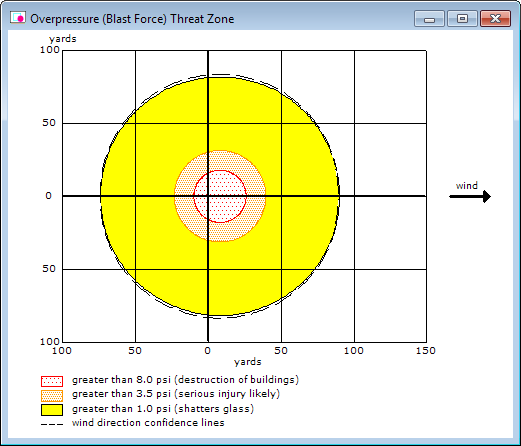Overpressure Levels of Concern
In ALOHA, an overpressure Level of Concern (LOC) is a threshold level of pressure from a blast wave, usually the pressure above which a hazard may exist. When you run a vapor cloud explosion scenario in ALOHA, overpressure is the hazard that is modeled. (ALOHA does not model the threat from hazardous fragments, which may travel far beyond the predicted overpressure threat zones.)
Overpressure
Overpressure, also called a blast wave, refers to the sudden onset of a pressure wave after an explosion. This pressure wave is caused by the energy released in the initial explosion—the bigger the initial explosion, the more damaging the pressure wave. Pressure waves are nearly instantaneous, traveling at the speed of sound. Although a pressure wave may sound less dangerous than a fire or a toxic cloud, it can be just as damaging and just as deadly. The pressure wave radiates outward and generates hazardous fragments (such as building debris and shattered glass). Additionally, these waves can damage buildings or even knock them flat—often injuring or killing the people inside them. The sudden change in pressure can also affect pressure-sensitive organs like the ears and lungs. The table at the bottom of this page relates overpressure values to the structural and physiological effects produced.
ALOHA's Default Overpressure Levels of Concern
Unlike toxic LOCs, no well-defined guidelines or standards exist to evaluate the overpressure hazard. So, ALOHA uses default overpressure values (in pounds per square inch, psi) that are based on a review of several widely accepted sources on overpressure and explosions:
- 8.0 psi (destruction of buildings)
- 3.5 psi (serious injury likely)
- 1.0 psi (shatters glass)
If you model a vapor cloud explosion scenario in ALOHA using the default LOCs, your threat zone estimate will look similar to the one pictured below. The red, orange, and yellow threat zones indicate the areas where the overpressure is predicted to exceed the corresponding LOC at some time after the release begins. (Note that the text accompanying the default LOC values are examples of effects that could occur if that value is exceeded; see the table below for more details about possible damage at various overpressure levels.)

Using Other Overpressure Levels of Concern in ALOHA
If you prefer, you can enter up to three overpressure values of your own (rather than use the default values). On the Overpressure Level of Concern dialog box, simply choose "User specified" from the drop-down list of LOC values and type in your own LOCs. When setting your own overpressure LOCs, you may want to refer to the table below, which relates overpressure values to the structural and physiological effects produced.
| Overpressure* (psig) |
Expected Damage | |
|---|---|---|
| 0.04 | Loud noise (143 db); sonic boom glass failure. | |
| 0.15 | Typical pressure for glass failure. | |
| 0.40 | Limited minor structural damage. | |
| 0.50-1.0 | Windows usually shattered; some window frame damage. | |
| 0.70 | Minor damage to house structures. | |
| 1.0 | Partial demolition of houses; made uninhabitable. | |
| 1.0-2.0 | Corrugated metal panels fail and buckle. Housing wood panels blown in. | |
| 1.0-8.0 | Range for slight to serious laceration injuries from flying glass and other missiles. | |
| 2.0 | Partial collapse of walls and roofs of houses. | |
| 2.0-3.0 | Non-reinforced concrete or cinder block walls shattered. | |
| 2.4-12.2 | Range for 1-90% eardrum rupture among exposed populations. | |
| 2.5 | 50% destruction of home brickwork. | |
| 3.0 | Steel frame buildings distorted and pulled away from foundation. | |
| 5.0 | Wooden utility poles snapped. | |
| 5.0-7.0 | Nearly complete destruction of houses. | |
| 7.0 | Loaded train cars overturned. | |
| 9.0 | Loaded train box cars demolished. | |
| 10.0 | Probable total building destruction. | |
| 14.5-29.0 | Range for 1-99% fatalities among exposed populations due to direct blast effects. | |
| * These are peak pressures formed in excess of normal atmospheric pressure by blast and shock waves. | ||
| Lees, Frank P. 1980. Loss Prevention in the Process Industries, Vol. 1. London and Boston: Butterworths. | ||
 An official website of the United States government.
An official website of the United States government. 